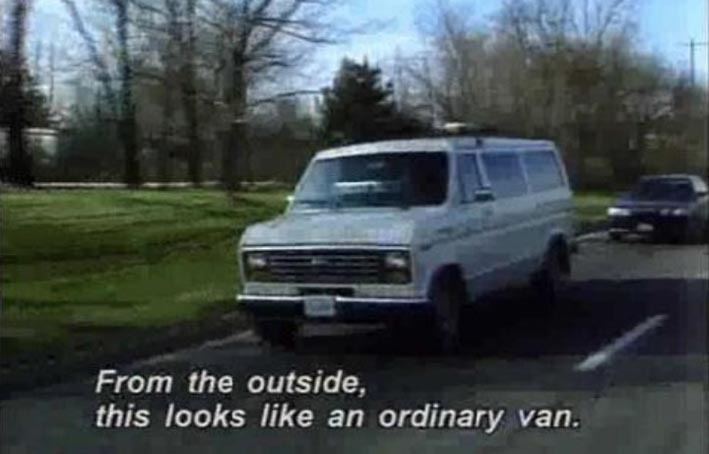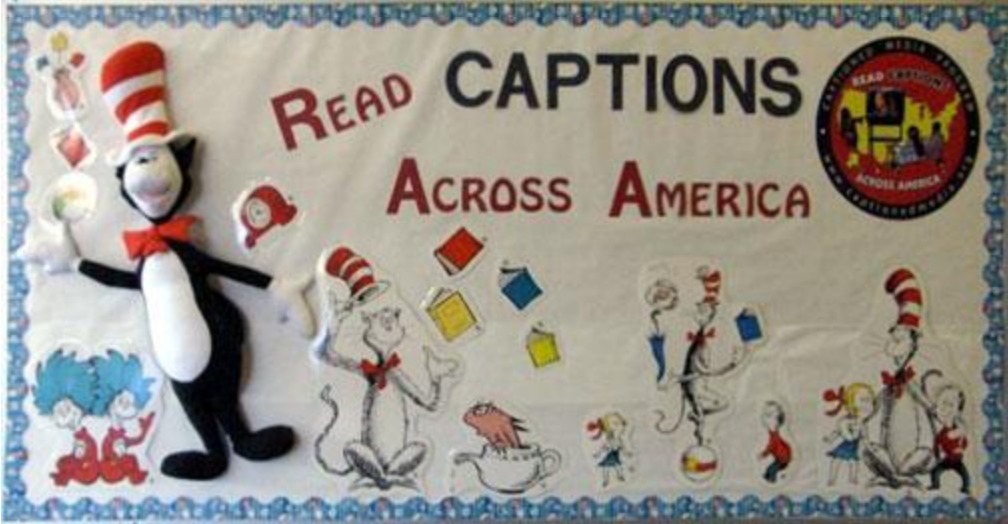<< Learning Center
Media Accessibility Information, Guidelines and Research
Read Captions Across America
By Bill Stark
Introduction
The National Education Association (NEA) annually sponsors an event called Read Across America. Originally created as a one-day celebration of reading on March 2, Dr. Seuss's birthday, the activity has grown into a nationwide initiative that promotes reading every day of the year. The result has been a focus of the country's attention on how important it is to motivate children to read, in addition to helping them master basic skills.
The Described and Captioned Media Program (DCMP) is a partner of the NEA for this activity, with the DCMP placing emphasis on the benefits of reading captions. "A picture is worth a thousand words, but add print to the sound and TV becomes a reading tutor." (Captions For Literacy, 2008).
The DCMP provides free-loan educational captioned media (DVD, CD-ROM, and Internet streaming) for teachers and families who have students with a hearing loss. It is supported through funding by the U.S. Department of Education and administered by the National Association of the Deaf.
About Captions
Captioning is the process of converting the audio content of a television broadcast, webcast, film, video, CD-ROM, DVD, live event, or other productions into text and displaying the text on a screen or monitor. Captions not only display words as the textual equivalent of spoken dialogue or narration, but they also include speaker identification, sound effects, and music description.
Terminology to describe captioning varies widely and is often confusing to consumers. Most TV captions are referred to as "closed captions" because a built-in decoder chip must be used to open (make visible) the captions. See figure 1. Subtitles for the deaf and hard of hearing (SDH) are often a menu option on DVD, and they also appear on DCMP DVDs and streamed media. SDH looks a lot like captions, and conveys the same information. See figure 2.


Also, an increasing amount of content on the Internet has sound. Some of it is captioned. Captions are critical reading aids for audio and video played through multimedia players such as Quicktime, RealPlayer, or Windows Media Player, but can also pertain to such technologies as Flash, Shockwave, or Java when audio content is a part of the multimedia presentation.
Captions: A Literacy Tool for Almost Everyone
While captions were originally developed for individuals who are deaf or hard of hearing, they are an aid to the reading and literacy skills development of many others. In the mid-1980's researchers determined that captions "… can turn television into a moving story book, a steady stream of written language presented with both video and audio reinforcement." (Koskinen, Wilson, and Jensema, 1986). A little more than a decade later, research continued to demonstrate that "…captioned television can be used as a vehicle to literacy." (Lewis, 1999). Again recently educators were asking "…why not turn on the captioning and let them 'see' the words as they hear them? And for older children who can read, how about also turning off the sound so that they can follow along by reading the dialogue?" (Sundius, 2008).
In addition, research studies have continued to confirm the benefits of using captions with second language learners of all ages. Students using captioned materials show significant improvement in reading comprehension, listening comprehension, vocabulary acquisition, word recognition, decoding skills, and overall motivation to read.
With documentation of its benefits and research support, why is captioning not more widely used? One answer as to why more home television viewers do not watch captioning was recently revealed in survey results: "70% of those who never use captions said they would turn on captions if they knew about all the benefits of captions." (CaptionsON, 2008). DCMP experience confirms that educators are often unaware of the benefits to their students (see below). For these reasons, the DCMP Read Captions Across America campaign was born.
Benefits of Captions
- Captions help children with word identification, meaning, acquisition, and retention.
- Reading captions is motivating to reading.
- Captions can help children establish a systematic link between the written word and the spoken word.
- Pre-readers, by becoming familiar with captions, will have familiar signposts when they begin reading print-based material.
- Captioning has been related to higher comprehension skills when compared to viewers watching the same media without captions.
- Children who have a positive experience in reading will want to read; reading captions provides such an experience.
- Reading is a skill that requires practice, and practice in reading captions is practice with authentic text.
- Captions provide missing information for individuals who have difficulty processing speech and auditory components of the visual media (whether this difficulty is due to a hearing loss or a cognitive delay).
- Students often need assistance in learning content-relevant vocabulary (in biology, history, literature, and other subjects), and with captions they see both the terminology (printed word) and the visual image.
- Captioning is essential for deaf and hard of hearing children, can be very beneficial to those (Lewis) (Sundius) learning English as a second language, can help those with reading and literacy problems, and can help those who are learning to read.
Some Important Laws
Our government has recognized the need for captioning, and important laws have been passed which mandate its availability. These include:
- The Americans with Disabilities Act (ADA) of 1990 requires that state and local governments and private businesses (called ―public accommodations‖) ensure that individuals with disabilities are not excluded from or denied services because of the absence of auxiliary aids and services, such as captioning. Captioning makes aural information accessible to people who are deaf or hard of hearing. Since the passage of the ADA, the use of captioning has expanded. Entertainment, educational, informational, and training materials can be captioned for deaf and hard of hearing audiences at the time they are produced (such as for pre-recorded materials) or when distributed (such as for live presentations).
- The Individuals with Disabilities Education Act (IDEA), enacted in 1975 and subsequently amended, continues to ensure that all children with disabilities have the right to receive a free, appropriate public education. Every child served by IDEA is required to have an Individualized Education Plan (IEP) which provides a blueprint for special education and related services, such as captioning.
- The Television Decoder Circuitry Act of 1990 requires that all televisions larger than 13 inches sold in the United States after July 1993 have a special built-in decoder that enables viewers to watch closed-captioned programming.
- The Telecommunications Act of 1996 directs the Federal Communications Commission (FCC) to adopt rules requiring closed captioning of most television programming. Under the rules, 100 percent of all new, nonexempt English-language television programs must be closed captioned. Also, 75 percent of nonexempt English-language programs shown for the first time before January 1, 1998 must be closed captioned.
What is the DCMP's Read Captions Across America?
The NEA's Read Across America "... provides the NEA members, parents, caregivers, and children the resources and activities they need to keep reading on the calendar 365 days a year." The DCMP supports that activity by:
- Providing free-loan educational captioned media to registered users (teachers, families, and others who work with deaf and hard of hearing children).
- Acting as a captioning information center to provide answers to anyone's questions concerning captioned media.
- Maintaining a database for use by anyone in locating educational captioned media available for purchase.
- Assisting requesters (media producers, school personnel, and others) in learning to caption or in locating an expert to perform captioning.
- Supporting efforts by parents and educators to increase the availability of educational captioned media.
- Providing flyers, posters, bookmarks, and other free materials to remind everyone of the importance of reading captions.
Conclusion
As the NEA has said, "... teachers and principals seem to be more than happy to dye their hair green or be duct-taped to a wall if it boosts their students' reading." (National Education Association, 2009). But it is easier than that to take advantage of the TV captioning that is mandated by law—just turn on the captions! And it is painless (free-loan or delivered through Internet streaming) for parents and teachers who have children with a hearing loss to utilize the DCMP's collection of educational captioned media!
Over 32,000,000 Americans are deaf or hard of hearing. There are additional millions who are just learning to read, have difficulty reading, or are learning English as a second language. America needs captions!
Join librarians, teachers, and parents across America who are encouraging reading and introducing wonderful books through captioned media! See figure 3.

About the Author
Bill Stark was the project director for the Described and Captioned Media Program, a nonprofit organization funded by the U.S. Department of Education to provide free-loan accessible educational media to teachers, parents, and others involved with educating K-12 students who are blind, visually impaired, deaf, hard of hearing, or deaf-blind. On advocating for more (and better) captioning, he very much agreed with the sentiment expressed by Dr. Seuss in The Lorax: "Unless someone like you cares an awful lot, nothing is going to get better. It's not."
References
Captions for Literacy. "How TV Captions Help Learning To Read". 2008.
http://captionsforliteracy.org
Koskinen, R., R. Wilson, and C. J. Jensema. "Closed-Captioned Television: A New Tool for Reading Instruction." Reading World May 1985: 7.
Lewis, Margaret S. Jelinek. "Television Captioning: A Vehicle for Accessibility and Literacy". Idaho Assistive Technology Project. Disability Information Resources. 1999
http://www.dinf.ne.jp/doc/english/Us_Eu/conf/csun_99/session0057.html
National Education Association. "Background on Read Across America". 2002-2009.
Sundius, Jane. "Using Television for Literacy Skills". Audicious Ideas. Open Society Institute-Baltimore. 2008
VITAC/CaptionsON. "Captions Matter". CaptionsOn. 2008
Tags:
Please take a moment to rate this Learning Center resource by answering three short questions.

